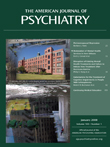Amygdala and Nucleus Accumbens Activation to Emotional Facial Expressions in Children and Adolescents at Risk for Major Depression
Abstract
Objective: Offspring of parents with major depressive disorder face a threefold higher risk for major depression than offspring without such family histories. Although major depression is a significant cause of morbidity and mortality, neural correlates of risk for major depression remain poorly understood. This study compares amygdala and nucleus accumbens activation in children and adolescents at high and low risk for major depression under varying attentional and emotional conditions. Method: Thirty-nine juveniles, 17 offspring of parents with major depression (high-risk group) and 22 offspring of parents without histories of major depression, anxiety, or psychotic disorders (low-risk group) completed a functional magnetic resonance imaging study. During imaging, subjects viewed faces that varied in intensity of emotional expressions across blocks of trials while attention was unconstrained (passive viewing) and constrained (rate nose width on face, rate subjective fear while viewing face). Results: When attention was unconstrained, high-risk subjects showed greater amygdala and nucleus accumbens activation to fearful faces and lower nucleus accumbens activation to happy faces (small volume corrected for the amygdala and nucleus accumbens). No group differences emerged in amygdala or nucleus accumbens activation during constrained attention. Exploratory analysis showed that constraining attention was associated with greater medial prefrontal cortex activation in the high-risk than in the low-risk group. Conclusions: Amygdala and nucleus accumbens responses to affective stimuli may reflect vulnerability for major depression. Constraining attention may normalize emotion-related neural function possibly by engagement of the medial prefrontal cortex; face-viewing with unconstrained attention may engage aberrant processes associated with risk for major depression.



